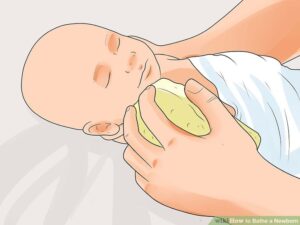As a new parent, giving your baby a sponge bath can feel daunting, especially if it’s your first time. But don’t worry—it’s simpler than it seems. Sponge bathing is ideal for newborns and babies with their umbilical stump still attached, as it avoids soaking them in water while keeping them clean and fresh. This guide will walk you through everything you need to know to safely and comfortably give your baby a sponge bath.
Why Do Babies Need Sponge Baths?
Sponge baths are recommended for newborns during the first few weeks of life, particularly while their umbilical cord stump is healing. Submerging your baby in water before the stump falls off can increase the risk of infection. Additionally, sponge baths allow you to clean your baby gently and safely, avoiding unnecessary stress or discomfort.
Benefits of Sponge Baths for Babies:
- Keeps their skin clean and healthy
- Prevents rashes and irritation
- Promotes bonding time between parent and baby
- Provides a safe alternative for babies not ready for a full bath
Supplies You’ll Need for a Baby Sponge Bath
Preparation is key when it comes to giving your baby a sponge bath. Having all the necessary supplies within arm’s reach makes the process smoother and safer.
Essential Items:
- A soft, clean towel
- Baby washcloths or sponges
- A shallow basin or bowl of lukewarm water (around 98°F or 37°C)
- Mild, baby-safe soap (optional)
- Cotton balls for cleaning delicate areas
- Diaper and fresh baby clothes
- A waterproof mat or pad for laying your baby down

Step-by-Step Guide to Giving a Baby Sponge Bath
1. Choose a Safe, Warm Environment
Pick a quiet, draft-free space where you can comfortably bathe your baby. The room should be warm (around 75°F or 24°C) to prevent your baby from feeling cold during the bath. Lay a soft, waterproof mat or towel on a flat surface to create a comfortable spot for your baby.
2. Prepare the Water
Fill a shallow bowl or basin with lukewarm water. Test the temperature with your wrist or elbow—it should feel warm, not hot. Avoid using boiling or cold water, as your baby’s skin is extremely sensitive.
3. Undress Your Baby
Gently undress your baby, leaving the diaper on for now to prevent accidents during the bath. Wrap them in a soft towel to keep them warm, exposing only the area you’re cleaning.
4. Start with the Face
Dip a clean washcloth in the water and wring it out until it’s just damp. Use this to gently wipe your baby’s face, avoiding the eyes and mouth. For the eyes, use a separate cotton ball for each eye and wipe from the inner corner outward.
5. Clean the Body
Unwrap one part of your baby’s body at a time to clean it. Use a damp washcloth to wipe their neck, chest, arms, and legs. Be sure to clean in the folds and creases where dirt and milk residue can build up.
Special Focus Areas During a Sponge Bath
Cleaning the Umbilical Cord Area
The umbilical cord stump should be kept clean and dry. Use a cotton ball or swab dipped in clean water to gently clean around the base of the stump. Pat it dry immediately with a soft cloth.
Cleaning the Diaper Area
Remove the diaper and use a damp washcloth to clean the diaper area. For girls, always wipe front to back to prevent infection. For boys, be gentle around the genitals, and don’t retract the foreskin if they are uncircumcised.
Cleaning the Head and Hair
If your baby has hair, use a small amount of baby-safe shampoo (optional). Wet their hair using the damp washcloth, apply a tiny bit of shampoo, and rinse gently with water.
Drying and Dressing Your Baby
After the bath, pat your baby dry with a soft towel, paying special attention to the creases and folds. Avoid rubbing their skin, as it can irritate. Once they’re scorched, put on a fresh diaper and comfortable clothes.
Safety Tips for Baby Sponge Baths
- Never leave your baby unattended. Always keep one hand on your baby during the bath.
- Avoid over-bathing. Two to three sponge baths a week are sufficient to keep your newborn clean without drying out their skin.
- Check the water temperature. Always ensure the water is lukewarm, not hot.
- Use gentle, fragrance-free products. Babies’ skin is sensitive, so opt for hypoallergenic and tear-free soaps or shampoos.

Signs Your Baby Enjoys the Bath
Babies often signal their comfort and enjoyment during a sponge bath by staying calm, smiling, or making soft cooing sounds. If your baby cries or seems uncomfortable, try speaking softly or singing to soothe them.
When to Transition to Regular Baths
Once your baby’s umbilical cord stump has healed (usually around 1–3 weeks), you can transition to bathing them in a baby tub. Always follow similar safety precautions to ensure a comfortable experience for your little one.
FAQs
1. How often should I give my baby a sponge bath?
Two to three times a week is enough unless they get filthy. Over-bathing can dry out their delicate skin.
2. Can I use soap for a newborn’s sponge bath?
It’s unnecessary, but if you choose to, use a mild, baby-safe soap in small amounts.
3. What should I do if my baby hates sponge baths?
Try to make the experience more enjoyable by singing, talking, or offering a soft toy. Keep the bath brief and ensure the room is warm.
4. When can I start giving my baby regular baths?
You can start giving regular baths once the umbilical cord stump falls off and heals completely.
5. What temperature should the water be?
The water should be around 98°F (37°C)—warm but not hot. Always test it on your wrist or elbow.

